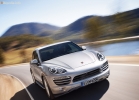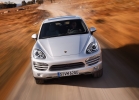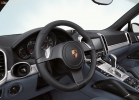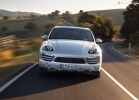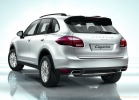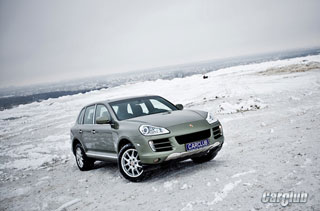Porsche Cayenne test drive since 2010 SUV
Porsche Cayenne with "folk" engines
Tsunami wash off cities, men turn into women, the axis of the earth shifts, I like Porsche with a diesel and automatic. I like much more than a machine with a gasoline engine! The former love for a manual gearbox has disappeared, it seems, forever. And now I don’t understand why the pen is needed! Where is the world rolling?

Yes, it was the gearbox that made the most strong impression on me during the budget Porsche Cayenne test with the two most popular V6 gasoline and diesel engines in the world. Formally, on Cayenne, of course, you can put 6-speed mechanics. However, it is available only with a V6 gasoline unit, and is intended for eccentrics who sincerely believe that only a manual box allows you to feel the machine. But I want to tell such AU guys, get out of a lethargic sleep, buy yourself vitamins, the time of dumb 3-speed automatic machines has passed.

The second -generation Cayenne can be equipped with a Bose musical system (basic equipment for Cayenne Turbo). There are 14 speakers here, an active sabwere at 200 watts and ten amplifier channels, and the total capacity of the system 585 watts. Bose sounds very decent. But if you are used to the concert sound, you will have to go broke and order a chic high-end class from Burmester. Its working characteristics are impressive: 16 separately controlled speakers, an active subwoofer with a capacity of 300 watts with an output cascade of class D and a membrane diameter of 250 mm, 16 amplification channels and total power of more than 1000 watts
The box is really good. It should be noted that the Germans decided not to put on Cayenne the PDK pre -sequential robot in their reserve, which can be found on Porsche cars. After all, such a checkpoint with two clutches is not the best suitable for driving on dirt or dragging heavy trailers of the transmission may simply not withstand excessive load. Therefore, it was decided to put a regular machine gun, which was developed by the Japanese company Aisin. Ordinary? Well, this is how to say: eight steps, the ability to switch manually with the help of steering wheel switches, but the main thing is excellent settings. The box allows, if desired, it is not 2-3 speeds down, but at once by four! It seems that you just calmly rolled at a speed of 70 km/h in the seventh gear (and the fifth is already turned on at 48-50 km/h), but you press the free space on the gas pedal and the number 3 appears almost instantly on the monitor 3.

If someone tells you that Porsche Cayenne and Volkswagen Touareg are one and the same, then do not believe. Yes, formally, both models are built on one platform. But these are different cars! After all, in the end, no one says that the 340-horsepower Audi TT RS and the base Skoda Octavia are the same machines. But they are also built on the same cart
Of course, if you wish, you can write a standard phrase that is standard for auto -journalism that there is a small delay when switching to low ones. But, believe me, this delay is so small that talking about her is simply funny. Few the driver will be able to work faster the lever of a mechanical checkpoint! In addition, the box is very smart. For example, during an aggressive driving, when you sharply release the gas pedal before turning to load the front, switching upwards does not occur. And in manual mode, when passing the turn to the limit, the machine itself does not jump to an increased even if the tachometer arrow is already in the red zone.

The new 8-speed Tiptronic S automatic machine is not only great, but also allows you to save fuel! Yes Yes. According to passport data, Cayenne with V6 gasoline and mechanics spends 15.9 liters per 100 km in the city. And with Tiptronic S, the consumption is 13.2 liters. The difference is more than noticeable!
Moreover, the driver can convert the box and engine to a sports mode (for this there is a special Sport button). And on Porsche Cayenne, unlike cars of other manufacturers, the difference between ordinary and sports modes is really noticeable! The programs switch even faster, increasing (and there are two seventh and eighth) are no longer used, the lowered are turned on at the first opportunity, the electronics forgets about fuel saving, and the car begins to go with all the money. And even with simple engines.

The front seats in the base have only eight directions. But the optional seats that can be adjusted as much as 18 (!) Positions are much more convenient in the basic Cayenne Turbo kit. Such chairs are perfectly tuned in to the figure! In addition, they can be equipped with heating and ventilation. Heating is proposed for the rear passengers
Although, what does it mean simple? After all, the V6 gasoline engine with a volume of 3.0 liters produces 300 hp. and 400 nm, and a 3.0-liter diesel has 240 hp. and 550 Nm. Of course, the V8 with a turbocharged, 500 hp And acceleration to hundreds in 4.7 seconds is cooler forever. But such cars are the top of the Cayenne line. Yes, and costs Cayenne Turbo with completely different money of almost 6.5 million rubles. Against 3.1 million per basic car with V6 (albeit with mechanics). Almost two -time difference! And many understand this very well. That is why Cayenne with gasoline V6 and diesel are the most popular. For example, in Europe, a diesel engine accounts for 72% of Cayenne sales, and in Asia (this also includes sales data in Russia and in the Middle East), the V6 gasoline engine has 68%.

In the basic configuration, Porsche Cayenne with an automatic machine has an Auto Start Stop system, which automatically turns off the engine when stopping, for example, at a traffic light. As soon as the driver removes the leg from the brake pedal, the engine immediately starts again. The delay in starting the motor, however, is present, but when driving in city traffic jams this does not annoy. It is interesting that the engine starting is blocked if the driver's door or hood is open. But this is not all the engine will not start if the driver does not fasten! True, Porsche understands that not everyone can like the Start Stop system. That is why it can be disabled. In addition, the system does not work if the Sport mode is included.
In addition to Auto Start Stop, fuel saving is achieved by a whole complex of measures. And not only a decrease in the mass of the car. For example, the function of energy recovery for the onboard network allows you to reduce the consumption by 0.15 liters per 100 km of path
In addition, the dynamic characteristics of the basic versions of Cayenne turned out to be very worthy. For example, Cayenne Diesel accelerates 0-100 km/h for 7.8 s. For comparison, the previous generation Cayenne with the same power of the engine performed this exercise in 8.3 s. This is what a decrease in the total mass of the car and another box mean!

In the basic configuration, Cayenne has a two-zone climate control, but the climate can already be four-zone for surcharge. In this case, the rear passengers can also adjust the temperature of the incoming air. However, our photos show the basic version
If you choose between V6 gasoline and diesel, I personally would vote for the last unit, even despite the formally smaller number of horsepower. There are several reasons. Firstly, the lower diesel consumption of 8.7 liters in the city against 13.2 liters. Secondly, the dynamic capabilities of the diesel Cayenne feels no different from the gasoline machine (this is also confirmed by the numbers: 0-100 km/h, both cars with machine guns are accelerated for the same 7.8 s). And, most importantly, Cayenne Diesel is quieter just Cayenne! Much quieter. If the sound of a gasoline unit somewhere after 3500-4000 rpm begins to put pressure on the ears and interferes with calmly, then the diesel engine is practically not heard even with intense acceleration.

Porsche Cayenne may have a reptity. But it is relevant only for Europe. Our car will receive a dock on which you can drive no faster than 80 km/h. And also a screwdriver will enter the car! The volume of the trunk of the second generation Porsche Cayenne from 670 to 1780 liters. The back door opens and closes with an electric drive. As an option, a system of organizing space with guides, telescopic bar and dividing luggage net is proposed
Now you are probably waiting for a story about the amazing controllability of Cayenne, about how you can take turns in lateral sliding on this model, slightly playing the gas pedal? We also wanted to experience it. To do this, they even violated all Porsche tips and left with common -recommended roads. Our path lay in the town of Nurbburg on the famous Nürburgring (few people know that Nordschleife or the northern loop is formally considered a public road, only paid, and the standard traffic rules even apply on it, such as overtaking on the right is prohibited). Moreover, Dmitry Sokolov rode with me in the car, who, by the way, recently, during the Racing of the VLN series with his team, took third place on Nordslife! He must definitely know how to ride a northern loop correctly, but all the fantasies about the Cayenne test on the world's most difficult track were broken to fluff last Friday, when we tested Cayenne on the roads of Germany, a historical one was held on Nordslife rally. And the entrance (or rather entry) was prohibited by ordinary mortals.
It's a shame? Of course. But without the green hell, Porsche Cayenne was able to prove that with handling this model, everything is in order of the new generation of the SUV, it holds the line perfectly, and for each action the steering wheel is an immediate adequate reaction. Moreover, talking about some kinds of rolls in the case of Cayenne is simply ridiculous, even when you pass the turns creaking with wheels. At the wheel of this car, you almost immediately forget that this is an SUV!

A person who came up with the display on the instrument panel readings of the navigation system should be paid a large bonus. Very comfortably! Well, we are pleased that navigation (like all menus) knows the Russian language
Our cars were equipped to the maximum. There was an active PASM suspension with the ability to adjust the rigidity of shock absorbers (in the basic configuration of all models, with the exception of Cayenne Turbo, there is a standard spring suspension). Thanks to Pasm, you can choose between three modes: Comfort, Normal and Sport. And the difference between them is very noticeable! Especially when comparing Comfort and Sport. In the latter case, Cayenne becomes tough, it clearly monitors all the bumps and makes you completely forget about such a concept as the rolls in corners. Here it is, the real Porsche! But, however, I want to go in Sport for a long time only on perfectly even paths. And as soon as all kinds of joints and patches begin, then there is a desire to make the car softer. And the Comfort mode allows you to transform the character of the machine! Although in this case a small swing is already becoming noticeable

It is interesting that the six -cylinder Cayenne of the second generation in their dynamic capabilities came close to the first generation SUV with a volume of 4.5 liters, which produced 340 hp. (or 450 hp if there is a turbine). After all, if the old Cayenne S began the beginning of the two thousandth years with the automatic transmission could accelerate to 242 km/h, and the set of a hundred hundred occupied 7.2 s with it, then the modern machine with gasoline V6 has a maximum speed of 230 km/h, and acceleration 0-100 m /h requires 7.8 s. About the consumption and there is nothing to say Cayenne S from the V8 model of the early 21st century, I spent 20.9 liters in the city, and the current six -cylinder Cayenne consumes 13.2 liters with automatic transmission. Diesel and at all 8.7 l
In addition to the PASM system, we also had a pneumatic suspension, which allows you to adjust the road clearance, the PDCC control system (it is not put on diesel engines). And that is not all. Cayenne with gasoline engines can still be equipped with an active all -wheel drive system called Porsche Torque Vectoring (PTV). She begins to work when passing a turn to the limit. How does the system work? As soon as the car stands on the arc, the inner in relation to the turning of the rear wheel slows down by the brake mechanism at the command of electronics. The car on the inhibitory wheel seemed to stumble, while the outer wheel through the inter -axial differential naturally receives a greater traction force. Regarding the vertical axis of the rotation of the car, there is a moment that pushes it on the intended arc! At the exit from the turn, the traction (and speed) on both rear wheels must be quickly leveled (only under such conditions the most effective acceleration is possible), for this, the interprete differential is blocked for a short time (multi -disc friction coupling, activated by the electric motor, was installed on Kayen and Tuare previous generation). PTV works very adequately in quick turns, a heavy SUV dies a good-minded sport-sedan with a hunt.

Another Porsche Cayenne option is an adaptive cruise control that controls the distance to the reducing car using the radar, automatically supports it and even slows down if necessary. Another security system is radar sensors in the rear bumper. At a speed of 30 to 250 km/h, they recognize cars in the dead zone and warn about them. And the car can be equipped with rotary headlights
Competitors are also not basting. For example, the BMW X6 has the rear axle with the possibility of differentiated wheel control (DPC Dynamic Performance Control). The task of DPC is similar to create a moment pushing the car into a turn. But it is realized differently. If the rear unloaded wheel is slowed down in Kayen in a bend, then on the X6, on the contrary, the thrust on the external loaded increases. The argument with such a system is somewhat more effective, since the speed of speed at the entrance does not occur. The rear gearbox, in addition to the differential, has two planetary programs that work with two clutches. When moving in a direct planetary transmission, they rotate idle. But, as soon as the electronics understands that one of the more loaded wheels (external relative to the rotation) needs to be twisted, the desired friction, having blocked, will let on an increased torque through the corresponding planetary transmission. Everything would be fine, but the planetary reducers X6 decently increase the cost. And on Porsche, they achieved the arguing effect with means that were already in the last generation (ESP plus the usual electromechanical blocking of differential). The only thing the developers did was only taught the systems to interact in accordance with the right time. Both Porsche with PTV and BMW with DPC provide more reliable behavior of the car in turns, but the differences of approaches sold by companies are noticeable only on the racing highway.

Depending on the engine, Porsche Cayenne has brake calipers of different color. Blacks are placed on ordinary Cayenne and Cayenne Diesel, silver in Cayenne S (atmospheric gasoline V8) and Cayenne Hybrid, and red calipers have Cayenne Turbo. But still, the coolest are yellow is the ceramic brakes Porsche Ceramic Composite Brake (PCCB). The size of the brake discs here is already 390 mm in front and 370 behind (on the version of Cayenne Turbo 410 mm and 370 mm, respectively). For comparison, the basic Cayenne with six -cylinder engines have 350 mm disks with a diameter
PTV is not available on diesel engines and a hybrid, since their rear differential is free. By the way, on a hybrid, the traction between the front and rear bridges shares the self -locking differential of increased Torsen friction. Cayenne with gasoline engines is equipped with a transmission that connects the front axle using an electromagnetic coupling (by default, the thrust transmitted to the front bridge is 10%, but the coupling can be blocked completely). The rear differential is blocked here using a friction coupling with an electric drive. In the previous generation, the transmission had a handout with an electron -valued center differential and lowering nearby. The percentage of drivers who operate Kayen on heavy off -road abandoned the latter, negligible. In addition, the rejection of the lowering series allowed to save 33 kg of weight, improve dynamics, controllability and efficiency. The absence of a lowering in some way is compensated by the shortest first and second gears of the new eight -speed machine.

By tradition, the ignition key in Porsche is located to the left of the steering wheel. A parking brake button is located next to the keyhole
How does the new Cayenne behave in the mud? I won't know how to lie. We traveled mainly only on asphalt. But we note that in the arsenal, the model has an off -road mode that changes the program of work of the checkpoint, ABS and all kinds of electronic systems. And in the presence of PASM and air suspension shock absorbers, it is possible to increase the road clearance (in the Cayenne Turbo version, it reaches a record 273 mm). If you have a gasoline car, that is, the function of blocking not only the center, but even the posterior interventure differential. Agree, it sounds good!
Conclusion
In my opinion, it is the diesel engine that is the most reasonable choice when buying Cayenne. After all, such a machine is perfectly controlled, has good dynamics, spends little fuel, and besides, the price is quite reasonable (of course, for the Porsche car). Of course, Cayenne Turbo rides much faster, but it costs 6,476,000 rubles! I have such money, I would have taken better diesel Cayenne for 3,135,000 rubles. And I would have purchased Porsche Boxster S with a 310-horsepower engine for 3,320,000 rubles, on which you can anneal in the summer for the whole coil.
Competitors
Porsche Cayenne has rivals, especially if you look at the basic versions of the model with six -cylinder units. As you already know, the basic version of Cayenne with an engine with a capacity of 300 hp. We have 3 103,000 rubles. (This is already with an automatic machine - cars with mechanics will not be sold in principle for us). However, this is the basic price to which all kinds of options must be added. For example, the installation of a full -sized spare wheel costs 41,379 rubles, adjustable in 18 directions of a chair with a fully leather finish of 244,279 rubles. (Partial leather decoration reduces the price to 90,749 rubles), heating of the windshield 22 830 rubles, the luggage engine electric drive 31,391 rubles, ceramic brakes 385 253 rubles, front seats 54,221 rubles, music from Burmester 227 727 rubles . (Bose costs 64,780 rubles).
Cayenne Turbo is a sweet for Porsche dessert. The car already in the database has an air suspension, the road clearance of this version is five millimeters larger. 500 horsepower and 700 Newton meters require adequate slowdown. The standard brakes of the TURBO versions have composite brake discs aluminum hub and a cast -iron ventilated rotor are connected by radial pins. Such discs are installed on the Audi R8 and A8. Carbonoraming brakes are available to order, they can be distinguished by yellow brake calipers
We have diesel Cayenne with 3,135,000 rubles, a car with atmospheric V8 (400 hp) is sold for 4,117,000 rubles, a hybrid costs 4,430,000 rubles, and Cayenne Turbo will cost 6,476,000 rubles. Although the equipment of the turbocharged Cayenne will be noticeably richer than the usual Cayenne, a lot can be spent on the options here. For example, a Cayenne Turbo Dream car with all kinds of bells and whistles would have cost us 8 million people. And this we thought far from all options!
So what are competitors offer? BMW can set in the class of large sports-class SUVs two models at once. This is the BMW X5 and X6. The cheapest BMW X5 with a 306-horsepower engine of 3.0 liters costs 2,919,000 rubles. Diesel BMW X5 XDRIVE30D (245 hp) is estimated at 3,028,000 rubles. The Porsche Cayenne S fights BMW X5 XDRIVE50i (407 hp), which costs 3,718,000 rubles. As for the BMW X5 M with a 555 hp engine, it also turns out to be cheaper than Cayenne Turbo by 1.3 million 5,158,000 rubles. Although this is not necessary to be surprised.
The BMW X6 is slightly more expensive and costs even a little more than the basic Cayenne. The BMW X6 XDRive35I version is estimated at 3,136,000 rubles .. diesel X6 XDRIVE30D is sold for 3,247,000 rubles. But Cayenne S is already more expensive than the X6 XDRIVE50i Bavarian machine with a turbocharged engine of 4.4 liters costs from 3,933,000 rubles. But the hybrid BMW X6 is already noticeably more expensive than Cayenne Hybrid. If Porsche costs 4,430,000 rubles, then for BMWACTIVEHYBRID X6 will take 4,990,000 rubles. Although there is different power. The hybrid Cayenne 380 hp, and in BMW already 485 hp
Mercedes-Benz ML, too, will perceive many as a competitor to Porsche Cayenne. Basin ML 350 (272 hp) and diesel ML 350 CDI (231 hp) cost 2,750,000 rubles in Russia. For models in a special series. For 388-horsepower ML 500 they ask for 3.5 million rubles. Well, the top ML 63 AMG (510 hp) is estimated at 4.8 million rubles.
Infiniti FX35 with a power engine of 320 hp It is sold with us from 2,490,000 rubles, and the FX50 version (400 hp) is estimated already at 3,499,000 rubles. This, of course, is cheaper than Porsche Cayenne, but do not forget that Porsche is higher than Infiniti in Porsche ranks.
There is also such a model as Range Rover Sport. A diesel car with a 3.0-liter engine (245 hp) is sold for 2,887,000 rubles. Range Rover Sport with a volume of 5.0 liters (375 hp) costs from 2,990,000 rubles.
Denis Smolyanov
photo by the author
Source: Auto.mail.ru

